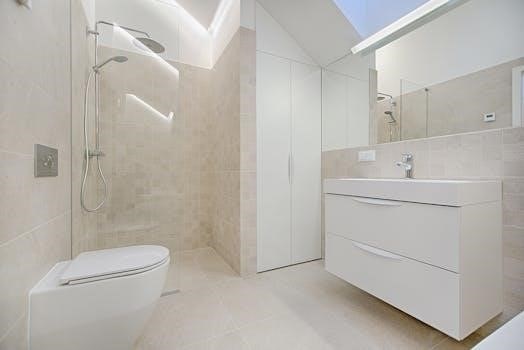New Home Checklist PDF⁚ Essential Elements
A new home checklist PDF is crucial for a smooth move. It organizes tasks, manages logistics, and prevents surprises. This template should include pre-move and post-move actions, covering everything from supplies to organization. Use it to ensure a stress-free transition into your new home.
Pre-Move Tasks
Before the big day, several crucial steps must be completed to ensure a smooth transition into your new home. Begin by figuring out your moving method, whether it’s hiring professionals or doing it yourself. Next, acquire necessary moving supplies, including boxes, tape, and packing materials. It’s also important to give appropriate notice to your current landlord, if applicable, and address any necessary repairs in your existing residence. Start organizing your belongings, deciding what to keep, donate, or discard. Don’t forget to schedule utility disconnections at your old place and set up new services at your new home. Gather all important documents and make copies. Notify relevant institutions about your change of address. Secure your internet provider for your new home. Develop a floor plan for your new home to assist with furniture placement. Consider creating signs for doors, to aid movers. Lastly, make sure to arrange for childcare or pet care during the move, if needed. A thorough approach to these pre-move tasks will significantly ease the entire process.
Moving Supplies and Logistics
Securing the correct moving supplies and managing logistics are paramount for a hassle-free move. Start by obtaining various sizes of sturdy moving boxes, ensuring you have enough to accommodate your belongings. Gather plenty of packing tape, bubble wrap, and packing paper to protect fragile items. Consider purchasing furniture pads or blankets to prevent scratches and damage during transport. It’s essential to have markers for labeling boxes clearly, indicating their contents and destination room. Begin making arrangements for a moving truck or van, if needed, and confirm dates with movers if you’re using a professional service. Evaluate the best method of transportation, considering the distance and the number of items you have. Plan the route to your new house, taking into account any possible traffic or road restrictions. Ensure that you have a first aid kit and a tool kit readily available. Have a plan for how you will move very heavy or oversized items. Make sure you have water bottles for all those involved in the move. Coordinating these logistics carefully will help streamline moving day.

New Home Shopping List
Creating a comprehensive new home shopping list is essential for settling into your new space. Begin with essential household items, such as basic cleaning supplies, including multi-surface cleaner, dish soap, and laundry detergent. Add to this list, necessary kitchen equipment like cookware, utensils, and dish towels. Include bathroom necessities like towels, a shower curtain, and bath mats. Prioritize bedroom items including bed linens, pillows, and blankets. Don’t forget to add any specialty items that fit your needs. Consider purchasing items such as small appliances (toaster, coffee maker), and any electronics you may need. Ensure you account for any items needed to maintain the exterior of your home, such as gardening tools. Keep track of items you already own to avoid unnecessary purchases. Evaluate your current furniture needs and add any new pieces to the list; Remember to include basic safety items such as a fire extinguisher and smoke detectors. The shopping list should be detailed and organized to help you avoid last-minute trips to the store. This list helps you to keep track of everything you need.
Move-In Day Essentials
Move-in day requires careful planning and a list of essentials to ensure a smooth transition. Start with a box of crucial items to keep accessible, including toiletries like soap, toothpaste, and toilet paper. Include basic tools such as a screwdriver, hammer, and utility knife for immediate assembly or repairs. Ensure you have water bottles to stay hydrated and snacks to keep energy levels up. Pack a first-aid kit with bandages, pain relievers, and any personal medications. Keep important documents like your lease, IDs, and insurance papers readily available. Have your phone charger and any necessary electronic accessories easily accessible. Don’t forget cleaning supplies for quick cleanups. Include bed linens so you can have a comfortable place to sleep after a long day. A change of clothes is also a good idea. Keep a flashlight handy in case of power outages or for navigating in the dark. Having these essentials will help you feel more comfortable and prepared on your first day in your new home. Remember, proper preparation reduces move-in day stress.
Home Building Checklist
Building a home is a complex process that necessitates a detailed checklist to stay on track. Begin with financial planning, creating a realistic budget, and securing necessary funding. Next, focus on acquiring all essential permits and approvals from local authorities. Establish a relationship with reliable contractors, including architects, builders, and subcontractors. Develop a clear construction timeline and adhere to it closely. Make sure to select all necessary materials, taking into account quality and budget. Regularly inspect the building site to ensure all work meets your standards and specifications. Make sure all utilities are connected at the appropriate times. Schedule regular meetings with the project team to address any issues that arise. Document every step of the process, including contracts, invoices, and inspection reports. Stay informed about every critical stage, from foundation to final finishing. This structured approach helps you manage the home-building process effectively, ensuring a successful outcome. Finally, prepare for the final walkthrough to confirm everything is completed as planned. A well-executed plan leads to a well-built home.
Post-Move Organization

Post-move organization is crucial for transforming a new house into a comfortable home. Begin by unpacking essential boxes first, focusing on kitchen, bathroom, and bedroom items. This allows you to settle in and have access to necessities. Next, take a room-by-room approach, unpacking and organizing items systematically. Consider purchasing storage solutions, such as shelves, drawers, and bins, to maximize space and maintain order. As you unpack, discard any items you no longer need or use. Create designated areas for specific items to prevent clutter from accumulating. Take the time to set up systems for managing mail, paperwork, and other household items. Label all storage containers for easy identification and access. Organize closets, pantries, and storage areas to keep everything neat and efficient. Hang pictures and decorate to personalize your new home. Establish routines for managing household chores and maintenance. Gradually organize less frequently used items, ensuring everything has its place. Once unpacked, take a moment to assess the overall organization and make necessary adjustments. Post-move organization sets the tone for a well-functioning and enjoyable living space.
Cleaning and Chore Schedule

Establishing a cleaning and chore schedule is essential for maintaining a tidy and organized home. Begin by creating a list of all cleaning tasks, such as vacuuming, dusting, and bathroom cleaning. Next, determine the frequency at which each task needs to be completed. Some tasks may require daily attention, while others can be done weekly or monthly. Designate specific days and times for each chore, ensuring that the schedule is realistic and manageable. Use a calendar or planner to track your cleaning and chore schedule. Assign chores to different members of the household to distribute the workload. Consider using a checklist to monitor progress and ensure that all tasks are completed. Implement a system for restocking cleaning supplies to avoid running out. Develop a routine for tidying up daily to prevent clutter from accumulating. Make time for deep cleaning tasks, such as scrubbing floors and cleaning windows. This should be included in your routine. Periodically review and adjust the cleaning and chore schedule as needed. It is important to be flexible. Consistent adherence to the schedule will help to maintain a clean and healthy home. A well-structured schedule ensures that the entire house is kept in good condition.

Home Inspection Checklist
A thorough home inspection checklist is essential when moving into a new property, whether it’s a rental or a purchased home. This checklist should cover all areas of the property, both interior and exterior, to identify any existing issues or potential problems. Begin with the exterior, noting the condition of the walls, roof, windows, and doors. Check for any signs of damage, such as cracks, leaks, or broken fixtures. Move inside and inspect each room, paying attention to the floors, walls, ceilings, and electrical outlets. Test all appliances to ensure they are working properly. Evaluate the condition of wet areas like bathrooms and the kitchen, checking for leaks or mold. Examine the plumbing and hot water systems. Note the condition of light fittings and stairwells. Check for any damage to the walls, ceilings, and doors. Pay particular attention to the condition of the windows. Look for signs of pests or rodents. Document all findings with photographs and detailed descriptions. A detailed home inspection checklist will ensure that any problems are addressed promptly. Using this checklist as a guide, you will have the best chance of finding all problems.
Editable Checklist Templates
Editable checklist templates are invaluable tools for managing the complexities of a move. These templates offer flexibility, allowing users to customize them to their specific needs. Whether you’re using Excel, Google Sheets, or a dedicated template editor like Canva, these templates can be adapted to track tasks, create shopping lists, and manage moving logistics. You can adjust the pre-made lists, add specific items, and mark tasks as complete. Editable templates can be formatted for various purposes, such as move-in day essentials, pre-move tasks, or post-move organization. This allows you to personalize the checklist to your unique situation. They often include sections for household items, packing lists, and moving checklists. These templates are also designed to be printable and shareable. These templates are often available as digital downloads. With templates that are easy to use, you can be sure to complete all tasks. Using these templates can provide a structured approach to your move. They also allow you to keep all essential information in one easily accessible place. These templates are also useful for sharing with family and friends. They will help you throughout the move.
